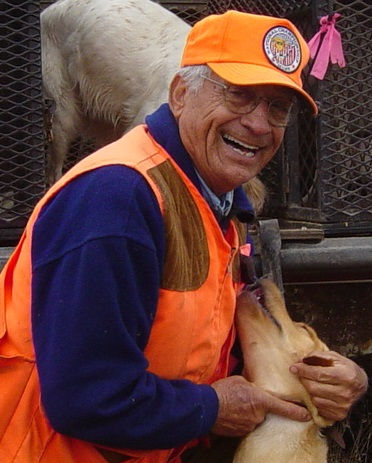A Quailing Addict
- Captain Gary Lockee
- Sep 6, 2023
- 4 min read
Updated: Feb 6

Originally published in February 2022 in the Field Trial Review, the original publication of Hunt & Field Magazine.
Reading reports in Covey Rise Magazine by Dr. Dale Rollins stimulates my recording this story. One would think that someone who has quail hunted for some 90 years and campaigned champion field trial dogs for some 50 years would become somewhat of an “expert” on quail and quail habitat. Not so! The more I engage myself with these crafty creatures the less I seem to know about them.
I was born in 1922 on a small farm in North Carolina. From my first remembrance, I do not recall not having a bird dog in the yard. The first one named Guy was an English Pointer. I must have been four years of age at the time. Ole Guy was followed by a big black and white setter named Rex. Then came another setter named Dan. I was authorized to call Dan my own and first bird dog.

By the time I was six, I was privileged to follow my dad and granddad on some short quail hunts. As I advanced in age, I was allowed to go along to carry the lunch bags, watch the dogs perform, and watch my folks do the shooting and the dogs do the retrieving. An additional chore was added - watch the singles down! A lunch bag for a small youngster got heavy after three hours of lugging it through the various places where Mr. Bob White might be hanging out. Needless to say, stopping by a stream or some old felled logs to consume the contents of that heavy lunch bag was a highlight almost superior to watching the dogs hunt, on point, and retrieve.

Attending school was an essential part of our weekly routine. I looked forward to each Saturday during the hunting season, hoping to accompany my dad on the Saturday hunt. Keeping in mind that there were many farm chores that had to be accomplished, many of which had to be accomplished on the week-end. Anticipating this fact, each day as I returned from school, I begged my parents to let me accomplish my weekend chores on each of the week days. I thought this would qualify me to accompany my dad on his Saturday quail outings. Although I was only allowed to tag along on these early hunts, it was not until I reached 12 years of age that I was able to take along a gun. This gun being a 410 bore – the worst possible weapon to put in the hands of a youngster. It took a long time and the expenditure of lots of ammunition to down my first quail. Later in life, a few trips to the skeet range, graduating to a 16 gauge, I was able to kill enough birds to provide the basic ingredients to make a good batch of quail gravy. Not too bad when served with my mother’s hot biscuits!

These early experiences were the facts that thrust me into becoming an addict to the sport of quail hunting and the enjoyment of walking behind some of the best bird dogs. I’ve been blessed to hunt these crafty birds for nearly 90 years. Not nearly as much as I would have liked! These experiences have included hunting in most of the eastern states, the south, mid-west and Texas. Since retirement from the United States Navy, my quail hunting honey holes have primarily been in South Texas. I’ve experienced some exceptionally good years, fair years, and a few poor seasons in South Texas. These experiences have been on several of the popular South Texas ranches.
I’ve really enjoyed some 40 years of Texas quailing experiences. They’ve taken me to such places as the Pitchfork and Four 6s ranches in Northern Texas to the King, Santa Fe, Kennedy, Armstrong, McGill, Garza Ranches in South Texas. Over this time span, it has not been unusual to find 20 + coveys in a normal day. Further, during such times as recently described by Dr. Rollins, it is not unusual to find as few as two coveys in a day. These latter experiences cause one to wonder what is going on in the lives of Mr. Bob, and to ask questions. So, I contacted several quail hunters in and around the area – with the results markedly on the downside. I contacted wildlife biologists. Their reports are on the downside. Contact with ranchers - poor results. Most all of those contacted provide answers mostly related to the weather, over cattle grazing, too much cover, no grazing, deer hunting, perdition, insufficient rain, plus many other reasons. I have heard no one say that over hunting has caused a decrease in the depleted population of quail. I’ve often heard from old time Texans that when the quail population is down, a quail explosion can take place a year later if there is sufficient rainfall during the nesting season. This no doubt might have been true sometime in the past. It did not appear, as an example, to happen in 2010 as has recently been observed, even though it was reported that there was favorable rainfall in the spring and early summer of 2010.

Regardless of the poor quail population for the 2010-2011 season, South Texas is a wonderful place to exercise and enjoy your bird dogs, kill a quail or two, make a neat batch of quail gravy to heap on a hot southern biscuit, and thank the Almighty for life, liberty and the continued pursuit of happiness and for the opportunity to live in such a wonderful country as our United States.
I’ve often been asked how a career seagoing Naval Officer could participate in quail hunting to the extent he reports. Yes, there were times during WW II and the Vietnam War that my efforts in the quail venues were restricted/limited. However, when the opportunity prevailed, I attempted to make up for the lost time when not at sea!
Note: Captain Lockee is a retired Naval Officer with some 33 years of Naval service. He is a founder of the Bird Dog Foundation located in Grand Junction, Tennessee. He served as its primary builder, President, Chief Financial Officer, and Board Member. It’s been reported that he became addicted to quail hunting and quailing activity at the age of six and some 90 years later hasn’t recovered. Both he and one of the dogs he owned have been elected to the Field Trial Hall of Fame.






























GOD bless The Captain as he's now hunting his favorite game bird up in HEAVEN. Always the consumate gentleman, bird dog aficionado and Quail hunter extraordinare! Sure am grateful that I got to know him...🙏👍☝💪🇺🇲🇺🇲🇺🇲